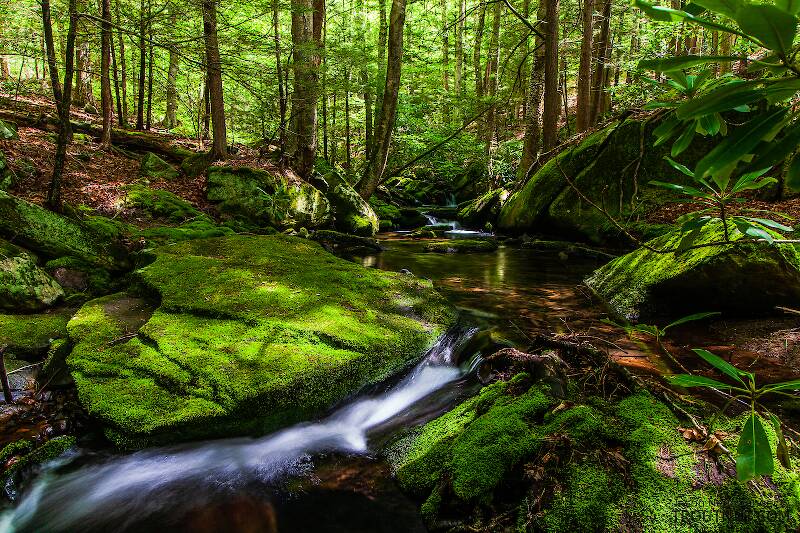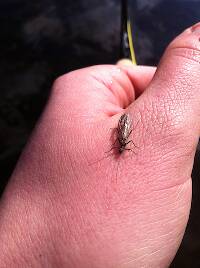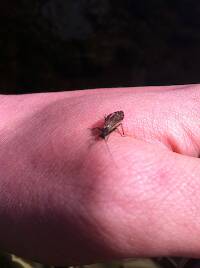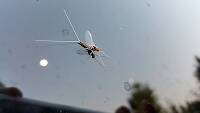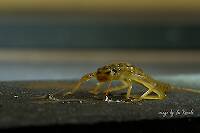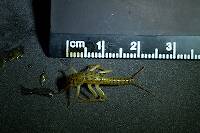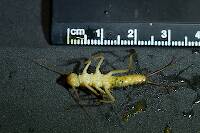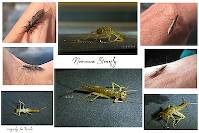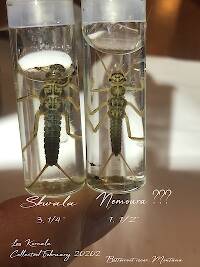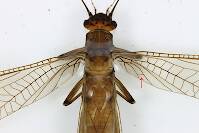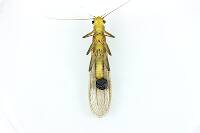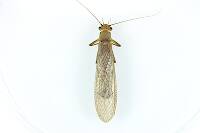
Hex Mayflies
Hexagenia limbata
The famous nocturnal Hex hatch of the Midwest (and a few other lucky locations) stirs to the surface mythically large brown trout that only touch streamers for the rest of the year.
Featured on the forum

This specimen keys to the Epeorus albertae group of species. Of the five species in that group, the two known in Washington state are Epeorus albertae and Epeorus dulciana. Of the two, albertae has been collected in vastly more locations in Washington than dulciana, suggesting it is far more common. On that basis alone I'm tentatively putting this nymph in albertae, with the large caveat that there's no real information to rule out dulciana.

Troutnut is a project started in 2003 by salmonid ecologist Jason "Troutnut" Neuswanger to help anglers and
fly tyers unabashedly embrace the entomological side of the sport. Learn more about Troutnut or
support the project for an enhanced experience here.
Sayfu
Posts: 560
Posts: 560
Sayfu on Jul 30, 2013July 30th, 2013, 6:21 am EDT
I turned to several Madison River, and another Montana River website for a fishing report, and twice it was reported that there "still were big nocturnal stone flies around" so fish a nocturnal stone pattern early in the morning. I called several of the fly shops in Island Park, ID not that far from the Madison, and they couldn't identify it. One shop said "maybe they meant caddis." Kelley Galloup of Michigan, and now Slide Inn fame on the Madison was one of the sites that reported the "big nocturnal stone." It is really to early for Claassenia to be emerging. We call those mutant stones, and the big, female egg layers are out flying upriver along the bushes early in the morning.
Taxon on Jul 30, 2013July 30th, 2013, 10:46 am EDT
Hi Jere-
In as much as most stoneflies are "nocturnal" emergers, that doesn't seem to provide any useful identifying information. However "big" is much more useful. I suspect the largest stoneflies of family Pteronarcidae can be eliminated from the equation, as they would have surely been referred to on fly fishing websites or in fly shops as Salmonflies. So, I suspect what is being referred to is a stonefly of family Perlidae, which includes the following in ID:
Calineuria californica (Western Stone)
Claassenia sabulosa (Shortwing Stone)
Doroneuria theodora (Montana Stone)
Hesperoperla pacifica (Golden Stone)
The only one of these that is not very well known is Dorineuria theodora, so my guess is, it may be the culprit.


Hope this helps,
In as much as most stoneflies are "nocturnal" emergers, that doesn't seem to provide any useful identifying information. However "big" is much more useful. I suspect the largest stoneflies of family Pteronarcidae can be eliminated from the equation, as they would have surely been referred to on fly fishing websites or in fly shops as Salmonflies. So, I suspect what is being referred to is a stonefly of family Perlidae, which includes the following in ID:
Calineuria californica (Western Stone)
Claassenia sabulosa (Shortwing Stone)
Doroneuria theodora (Montana Stone)
Hesperoperla pacifica (Golden Stone)
The only one of these that is not very well known is Dorineuria theodora, so my guess is, it may be the culprit.
Hope this helps,
Entoman on Jul 30, 2013July 30th, 2013, 3:20 pm EDT
Ditto Taxon's commentary. The only thing I can add is that two large taeniopterygid (Willowfly) species may be a possibility. Though usually thought of as late Winter - Spring hatchers, Schwiebert reported that both Taenionema pacificum and pallidum hatch in MT as late as August. I've seen them late myself, but never in numbers I would consider "fishable". Both can be as large as 20mm.
I wished the common name (Nocturnal Stonefly) was more help. Like the two of you, I have fished all over the West for more years than I care to mention and have never heard of it before, either. Perhaps (as Taxon seemed to suggest) the fly shop reports are merely describing their behavior?
I wished the common name (Nocturnal Stonefly) was more help. Like the two of you, I have fished all over the West for more years than I care to mention and have never heard of it before, either. Perhaps (as Taxon seemed to suggest) the fly shop reports are merely describing their behavior?
"It's not that I find fishing so important, it's just that I find all other endeavors of Man equally unimportant... And not nearly as much fun!" Robert Traver, Anatomy of a Fisherman
Sayfu
Posts: 560
Posts: 560
Sayfu on Aug 1, 2013August 1st, 2013, 5:30 am EDT
In the one breath Galloup reports there is a big nocturnal stonefly still around, and in the next breath he says we are using epeorus emergers......and that is what we caught fish on yesterday, my last season's designed pink albert soft hackle emergers. We caught 6-8 browns, and cutthroats, and were really fishing them the wrong time of day. We were off the water at 12:30, and emergence is in the later part of the day. Last year we had great success from 3:00 on.
PaulRoberts on Aug 4, 2013August 4th, 2013, 3:21 pm EDT
I thought most big stones were mostly nocturnal as adults.
Entoman on Nov 6, 2013November 6th, 2013, 10:07 pm EST
Hi Paul,
Yes - as a general rule for the vast majority of nearctic species. However, out West the important big boys engage in a lot of diurnal activity. Only 3 species make up the bulk of the biomass that is prodigious on many waters. Their hatches are also fairly consistent and coordinated. Each factor is at the opposite end of the scale from their eastern counterparts which explains why the former offer such renowned fishing while the latter don't.
Regardless the species that Jere may be referring to, it is pretty clear that the reports are mentioning it only as a model for searching patterns as opposed to an actual fishable hatch. Its behavior sounds more like that of the plethora of minor eastern species. I would wager that the "Nocturnal Stone" is either the Shortwing Stone or Montana Stone renamed by those with little knowledge of the angling history/heritage of these critters, let alone their taxonomy.:)
Yes - as a general rule for the vast majority of nearctic species. However, out West the important big boys engage in a lot of diurnal activity. Only 3 species make up the bulk of the biomass that is prodigious on many waters. Their hatches are also fairly consistent and coordinated. Each factor is at the opposite end of the scale from their eastern counterparts which explains why the former offer such renowned fishing while the latter don't.
Regardless the species that Jere may be referring to, it is pretty clear that the reports are mentioning it only as a model for searching patterns as opposed to an actual fishable hatch. Its behavior sounds more like that of the plethora of minor eastern species. I would wager that the "Nocturnal Stone" is either the Shortwing Stone or Montana Stone renamed by those with little knowledge of the angling history/heritage of these critters, let alone their taxonomy.:)
"It's not that I find fishing so important, it's just that I find all other endeavors of Man equally unimportant... And not nearly as much fun!" Robert Traver, Anatomy of a Fisherman
Byhaugh on Jan 15, 2014January 15th, 2014, 7:19 pm EST
I have been fishing that area for over 30 years.
The hatches referred to there are almost always referred to as stone flies. The insects are active fliers during the day. I believe they crawl out of the river to molt on rocks and in brush. When the day warms up, they begin flying around.
They are the Californicas.
The hatches referred to there are almost always referred to as stone flies. The insects are active fliers during the day. I believe they crawl out of the river to molt on rocks and in brush. When the day warms up, they begin flying around.
They are the Californicas.
Quick Reply
Related Discussions
Topic
Replies
Last Reply
2
Jan 19, 2010
by Dkak
by Dkak
0
Jun 4, 2016
by Wiflyfisher
by Wiflyfisher
5
Sep 9, 2016
by Feathers5
by Feathers5
1
Oct 28, 2008
by GONZO
by GONZO
2
Feb 24, 2020
by Leskorcala
by Leskorcala
9
Jun 17, 2015
by Oldredbarn
by Oldredbarn

